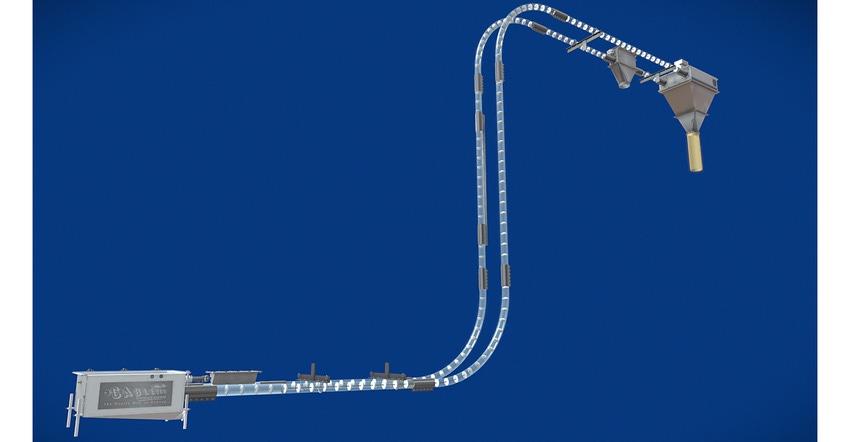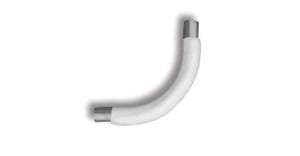Clarifying common questions and misunderstandings about tubular drag cable conveyors
January 31, 2022

Chances are that many buyers and sellers who process, handle, and package dry particulates can still be challenged to determine the type of conveyor they see on the plant floor. Among those comprised of conveyor tubes, the options are many: screw (augur), pneumatic, vacuum, aeromechanical, tubular drag chain and disc, or tubular drag cable and disc.
Many specifiers, architects, engineers, and other professionals lack substantial technical or hands-on experience with such conveyors. This knowledge gap can result in extreme consequences when delicate materials or precise blends must be reliably conveyed but instead, costly product destruction or inaccurate blends occur.
We will demystify one of the most misunderstood but useful types of these conveyors – tubular drag cable and disc conveyors – with industry expert Karl Seidel. Seidel is marketing director of Cablevey Conveyors, a mechanical conveyor manufacturer that serves the global powder and bulk solids, coffee, nut, pet food, and specialty food markets. Seidel’s company has designed, engineered, and serviced enclosed cable and disc tube conveyors for 50 years in more than 66 countries.
To clarify some of the most common questions and misunderstandings about tubular drag cable conveyors, we let Seidel provide answers to typical questions from industry professionals.
Q: What exactly are tubular drag cable conveyors and how can they benefit the powder and bulk solids industry?
A: Tubular drag cable conveyors gently move product through a sealed tube using a coated, flexible stainless-steel drag cable pulled through on a loop. Solid circular discs (flights) are attached to the cable, which push the product through the tube without the use of air. These conveyors excel in transporting delicate, precise blends of various powders and bulk solids in versatile layouts and configurations.
When transporting a blend of powder or bulk solid product with a conveyor system, maintaining a consistent mix ratio is essential, whether a fine powder, coarse mix, or larger variable-sized amalgams of different weights and shapes.
However, conventional conveyor systems are not specifically designed to precisely transport powder or bulk solid blends without changing the mix ratio. Various product material weights, sizes, and shapes can shift and disperse in open systems like bucket conveyors, and vibration can cause the blended product to shift throughout transport. Vacuum and pneumatic systems can cause smaller lightweight particles in a blend to move at different speeds than heavier or larger particulates, resulting in significant blend restructuring when the product reaches its discharge point.
In contrast, tubular drag cable conveyors are engineered to maintain precise blend ratios, which can be important for quality. As an example, the company’s engineers have resolved the issue with a completely enclosed, compartmentalized tubular conveyor system.
Like an endless succession of train cars, each space between solid circular discs holds a predefined volume of product. Based on the manufacturer’s specifications and requirements, engineers can calculate the optimal speed of the system, the most appropriate tube angles, and the proper construction design to guarantee their blended product remains consistent from input to discharge, even at high volumes.
Q: Aren’t tubular drag cable conveyors the same as screw systems?
A: One of the most common misconceptions is that tubular drag cable and screw conveyors are identical. Also known as auger conveyors, screw systems typically utilize a helical blade that moves granular materials within a tube. However, augurs can cause product damage and compromise blends. So, the units tend to be an option when material integrity is not critical.
The key difference to look for is that augurs convey material with a helical screw. The transfer speed is directly proportional to the rotation speed of the screw. On the other hand, tubular drag cable conveyors transfer material between two discs pulled by a sealed cable and are designed to protect delicate powder and bulk solid products and blends.
Q: Tubular drag cable conveyors have space and expansion limitations, correct?
A: Some in the powder and bulk solid industry do not consider tubular conveyors because they believe the systems cannot fit in their facility’s available space or accommodate its layout, which may include significant inclines or elevation changes. However, this is not the case.
Modular systems like tubular drag cable conveyors are an excellent option for complex layouts that could require curves or changes in direction.
Tubular conveyors do not have to be installed at 90 degrees and can use angles so can go in between, around, above or below existing equipment or other obstacles. That is important for existing facilities that may not have the flexibility to move something out of the way.
In addition, tubular conveyors are quite space efficient. To conserve space, the conveyor turnaround and its inlet can stand on end, so it is only one foot across instead of three. If conveyor discharge occurs best using gravity, tubing can be run through walls and discharge out of the building roof, which saves interior space.
Q: Cleaning requires dismantling and extended downtime, doesn’t it?
A: Between powder and bulk solid product changeovers, many traditional conveyor systems must be disassembled, cleaned, or soaked, and then reassembled – a labor and time-intensive process. However, this is not necessary for tubular conveyors.
It is common to see portions of tubular conveyor equipment extending outdoors when conveying product from outside to inside or vice versa, such as when unloading raw material or loading finished product.
With tubular conveyors dry, wet, and in-line cleaning options are available. Among dry options, brush boxes and air knives can clean the cable. Brushes and wipers can wash the tubes. To sanitize, a sponge soaked in sanitizer can be used without getting the system fully wet.
For the most thorough cleansing, the cable conveyor’s wet cleaning process internally washes the tube in several steps, starting with a water rinse followed by a foaming agent, a sanitizing rinse, and a final water rinse. Once the system is thoroughly flushed out, drying is achieved by attaching urethane wipers to the tubular conveyor’s discs, which “act like a squeegee” to remove any residual water.
With an outdoor conveying system, materials may travel from a feed mill to a production or packaging room which may be 10 ft or even 100 ft away.
Q: These conveyors are for indoor installation only, correct?
A: It is a common industry misunderstanding that tubular conveyors are only installed indoors. In fact, it is common to see portions of equipment extending outdoors. This may occur when conveying powder and bulk solid product from outside to inside, such as when unloading raw material from a truck or railcar or loading finished product into similar transport. Materials may also travel from a feed mill to a production or packaging room which may be ten feet or even one hundred feet away.
When some of the equipment is utilized outdoors, and when the company is moving a moist product, it can be helpful to wrap the tubes in heat tape to prevent moisture from condensing or freezing in the tubes. The conveyor manufacturer can also provide a range of accommodations to account for the effects of wind, dust, rain, insects, and direct sunlight.
For more info, call 800-247-3344, email [email protected], or visit cablevey.com
About the Author(s)
You May Also Like




